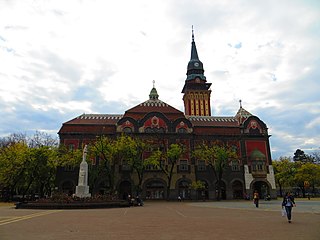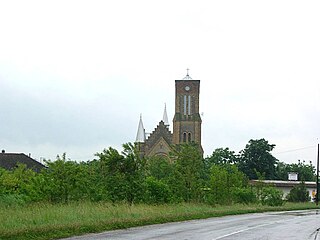
Subotica is a city and the administrative center of the North Bačka District in the autonomous province of Vojvodina, Serbia. Formerly the largest city of Vojvodina region, contemporary Subotica is now the second largest city in the province, following the city of Novi Sad. According to the 2022 census, the urban area of the city has a population of 94,228, and the population of metro area stands at 123,952 people.
Bunjevci are a South Slavic sub-ethnic group of Croats living mostly in the Bačka area of northern Serbia and southern Hungary, particularly in Baja and surroundings, in Croatia, and in Bosnia-Herzegovina. They presumably originate from western Herzegovina. As a result of the Ottoman conquest, some of them migrated to Dalmatia, from there to Lika and the Croatian Littoral, and in the 17th century to the Bácska area of Hungary.

Bačka or Bácska, is a geographical and historical area within the Pannonian Plain bordered by the river Danube to the west and south, and by the river Tisza to the east. It is divided between Serbia and Hungary. Most of the area is located within the Vojvodina region in Serbia and Novi Sad, the capital of Vojvodina, lies on the border between Bačka and Syrmia. The smaller northern part of the geographical area is located within Bács-Kiskun County in Hungary.
Vojvodina's demographic history reflects its rich history and its former location at the border of the Ottoman and Habsburg empires and at the confluence of various peoples, making it a hotbed of invasion, colonization, and assimilation processes. Currently there are more than 25 ethnic groups living in Vojvodina and six official languages.
The Hungarian Regional Autonomy is a proposed territorial autonomy for ethnic Hungarians in Serbia, located in the northern part of Vojvodina province.

Donji Tavankut, also known simply as Tavankut (Таванкут), is a village located some 16 km west of Subotica, Serbia. It is located in the Subotica municipality, in the North Bačka District of Serbia, in the Autonomous Province of Vojvodina.

Mala Bosna is a village located in the Subotica municipality, in the North Bačka District of Serbia. It is situated in the autonomous province of Vojvodina. The village is ethnically mixed and its population numbering 1,245 people.

Đurđin is a village located in the Subotica municipality, in the North Bačka District of Serbia. It is situated in the autonomous province of Vojvodina. The village is ethnically mixed and its population numbering 1,746 people.

Gornji Tavankut is a village located in the Subotica municipality, in the North Bačka District of Serbia. It is situated in the autonomous province of Vojvodina. The village is ethnically mixed and its population numbering 1,381 people.

Bikovo is a village located in the Subotica municipality, in the North Bačka District of Serbia. It is situated in the autonomous province of Vojvodina. The village is ethnically mixed and its population numbering 1,824 people.

Stari Žednik is a village located in the Subotica municipality, in the North Bačka District of Serbia. It is situated in the autonomous province of Vojvodina. The village is ethnically mixed and, according to the 2002 census, it has 2,230 inhabitants with a Croatian relative majority. According to the 2022 census, it has 1,564 inhabitants.

Čantavir is the largest village with Hungarian ethnic majority in the autonomous province of Vojvodina, Serbia. It is situated in the municipality of Subotica, North Bačka District. The village has a population of 6,951 inhabitants. The main occupation of the villagers is agriculture and stock breeding.

Novi Žednik is a village located in the Subotica municipality, in the North Bačka District of Serbia. It is situated in the autonomous province of Vojvodina. The village has a Serb ethnic majority and its population numbering 2,848 people. The village contains an elementary school, an old Orthodox church and a newly build Orthodox church as well a train station. The village has a Catholic minority who attend religious services in nearby village of Stari Žednik since there are no Catholic churches in this village. According to the 2022 census, it has 1,994 inhabitants.

Mišićevo is a village located in the Subotica municipality, in the North Bačka District of Serbia. It is situated in the autonomous province of Vojvodina. The village is ethnically mixed and its population numbering 446 people.

Croats of Serbia are a recognized national minority in Serbia. According to the 2022 census, the population of ethnic Croats in Serbia is 39,107, constituting 0.6% of the total population. The vast majority of them live in the northern autonomous province of Vojvodina, where they number 32,684 and make up 1.9% of the province's population. An additional 11,104 people declared themselves as Bunjevci in the 2022 census; there are differing views whether Bunjevci should be regarded as Croats or as members of a distinct ethnic group.

Bački Vinogradi is a village in Serbia. It is situated in the Subotica municipality, in the North Bačka District, Vojvodina province. The village has a Hungarian ethnic majority and its population numbering 2,039 people.

Bačko Dušanovo is a village in Serbia. It is situated in the Subotica municipality, in the North Bačka District, Vojvodina province. The village has a Hungarian ethnic majority and its population numbering 741 people.

Erzsébet Szilágyi was a Hungarian noblewoman, wife of John Hunyadi and mother of Matthias Corvinus, King of Hungary.

Croatian National Council of the Republic of Serbia is the representative body of Croats in Serbia, established for the protection of the rights and the minority self-government of Croats in Serbia.




















